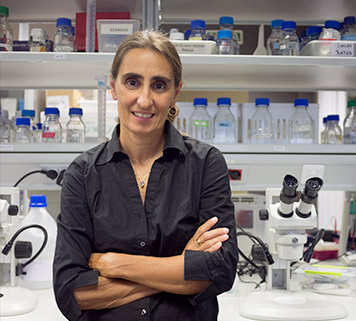The Evolution of Biological Systems: Biological Solution for Global Challenges
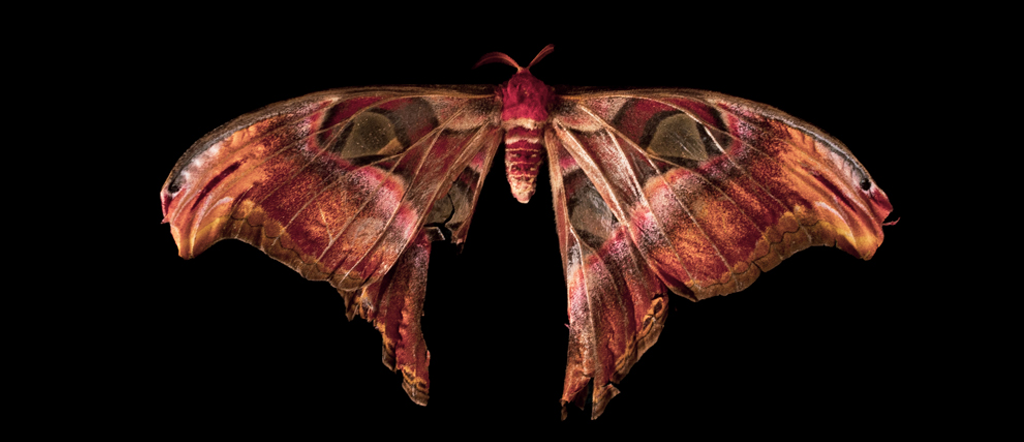
Photo: Simona Gaddi
Plastic degradation by biological systems
Plastics are synthetic molecules derived from fossil fuels and largely resistant to degradation. Mass production of plastics started after WWII and grew exponentially after the second half of 20th century. Polystyrene (PS) and polyvinyl chloride (PVC) were among the first to be created in the first half of last century, followed by the invention of polyethylene (PE) in the ‘50s. The production of these new materials burst over the past 60 years. They entered compellingly into our daily life, bringing a revolution in our society and a new way of living. Plastics became an essential material in many fields, as in infrastructures, electronics, medicine and bio-medical research, just to mention some. PE, PS and polypropylene (PP) account for 70% of plastic production world-wide.
However, this revolution came with a price, that is the accumulation of plastic waste.
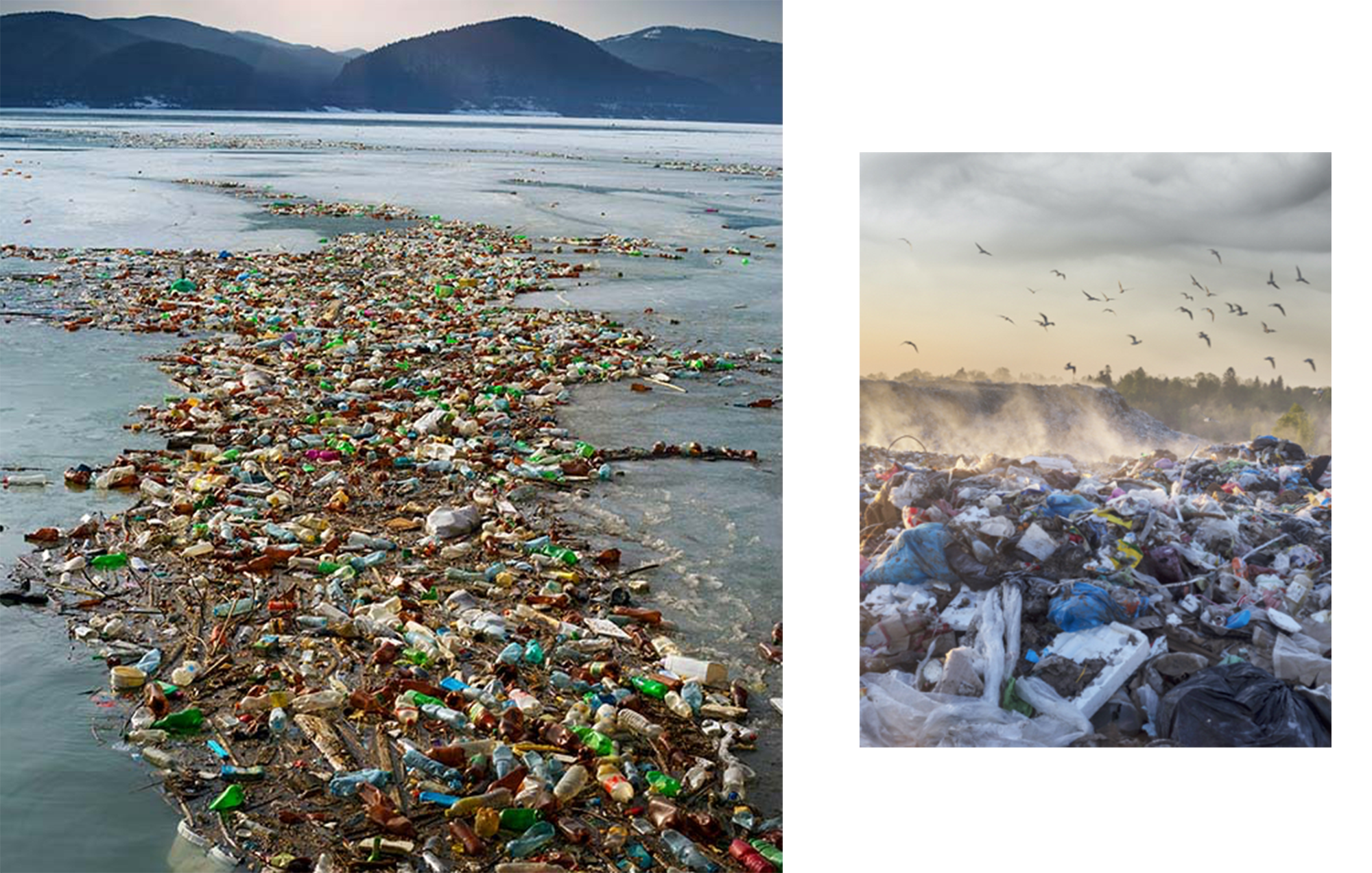
Plastic waste: ways to disposal
This massive usage of synthetic polymers generates the accumulation of millions of tonnes of plastic waste. In the past 40 years the production of plastics increased exponentially, with PE heading this trend by far (30% of plastic production). Although many efforts are on-going to minimise the environmental impact of plastic waste, millions of tonnes of residues are accumulated in landfill and dispersed in oceans and on lands continuously.
Where is the solution?
To-date, no solution is available to solve this urgent environmental threat. Plastic residues end up mostly into landfill sites, and hence diffuse into the environment (land, water and air). A small percentage is incinerated for energy recovery, a practise coming with an environmental cost we cannot assume any longer. Recycling has been sold as the solution for plastic pollution, but as it is to-date it is way far from it: mechanical recycling is not solving the problem, on the contrary it is helping to maintain it as it is, and delaying the quest for a real solution. It will stay this way until new recycling technologies are developed into useable applications.
What about recycling by biological means?
A new solution: plastic degradation by insects
Degradation by biological means is a relatively new way to approach the plastic waste disposal issue.
This relatively recent field has becoming depositary of big hopes after the discovery that larvae of some Lepidoptera and Coleoptera could degrade sturdy synthetic polymers as PE and PS.
Our lab discovered the fastest of all, the larvae of lepidopteran Galleria mellonella, also called wax worm.
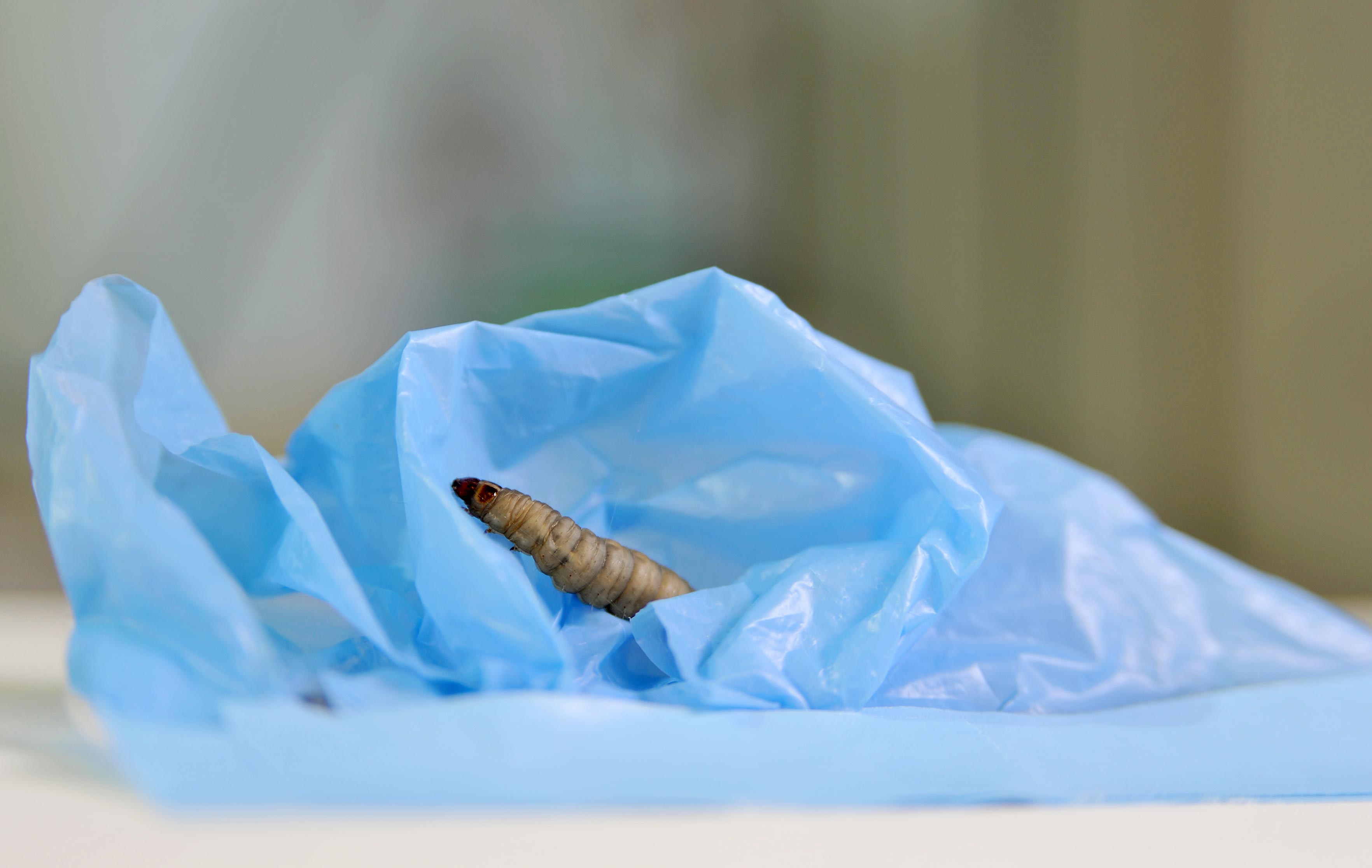
Photo: Cesar Hernandez
Lab Interests
The lab interests focus on insects as biological means to degrade sturdy fossil fuels-derived polymers, i.e. plastics.
Our main player is the wax worm, the fastest one’ the centre of our attention since the start (Bombelli et al., 2017). Since this first report about the capacity of the wax worm to oxidize, and therefore degrade, PE, many other reports confirmed and extended this capacity to PS. Adding to it the ability to oxidize PP as well (unpublished observations), this makes the wax worm the most suitable candidate in our quest for resilient plastics’ degraders.
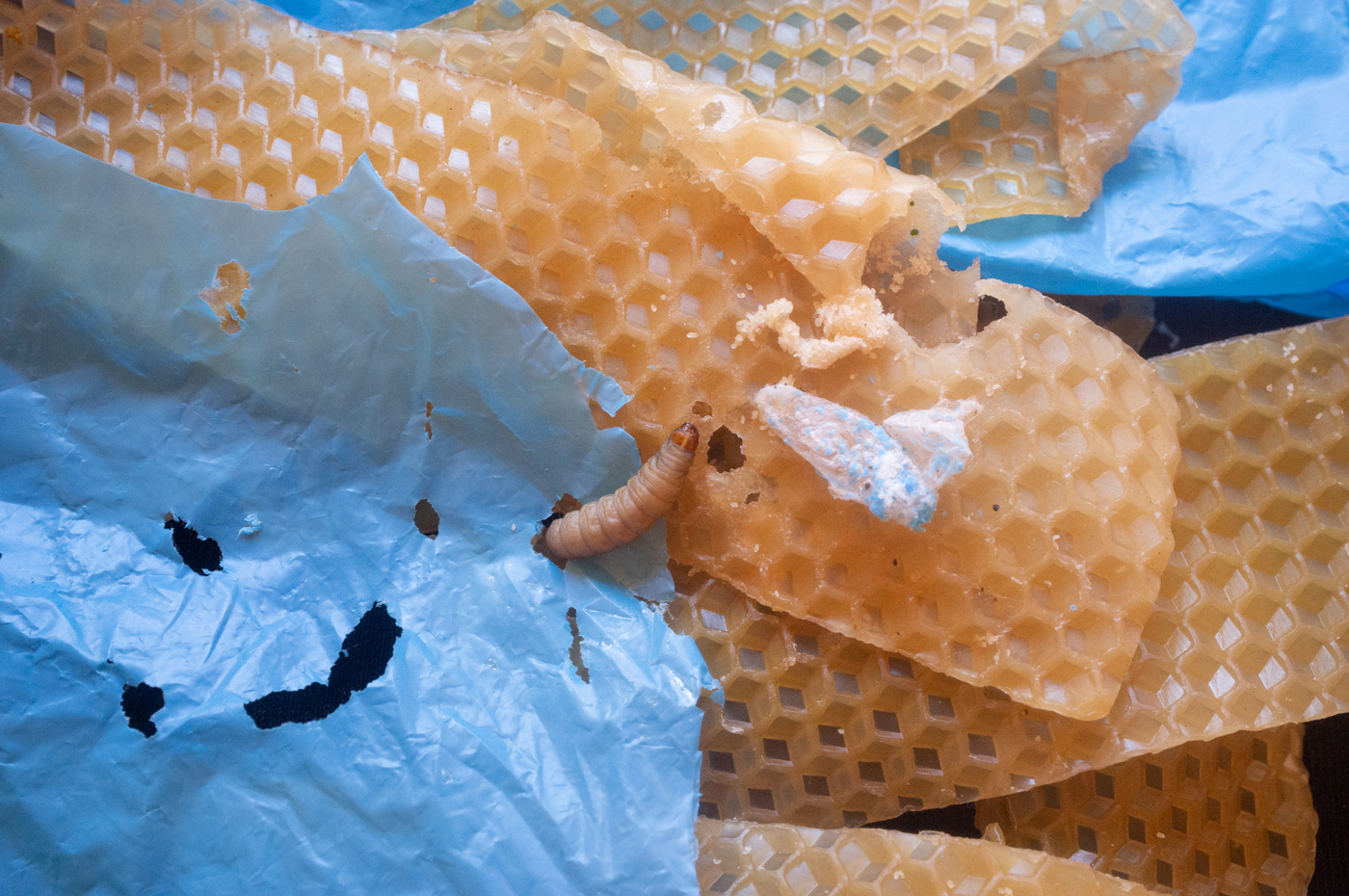
Photo: Simona Gaddi
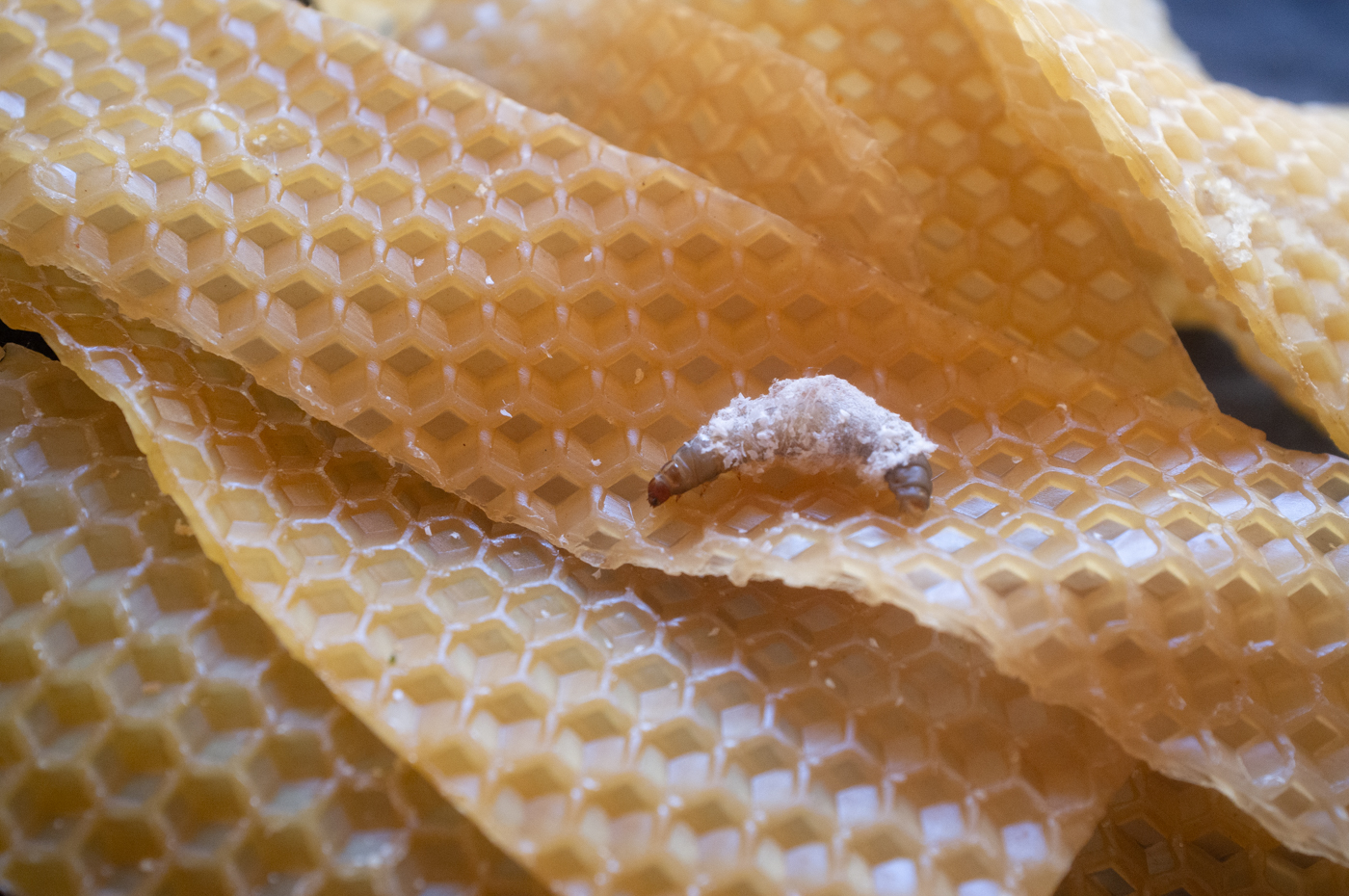
Photo: Simona Gaddi
Our lab has recently discovered the key to PE degradation by the wax worm. The liquid recovered from the larvae buccal cavity, that we generically called saliva, oxidizes and depolymerizes PE. Enzymes therein, two phenol-oxidases re-named Demetra and Ceres, are responsible for this effect (Nat. Comm., Sanluis et al., 2022, see below). Two more phenol-oxidases, re-named Cora and Cibeles have been identified, and their structure in the wax worm saliva characterized (Spinola et al., 2023, see below)
The research projects the lab is centred on starts from here.
1. Study of G. mellonella enzymatic activities involved in plastic degradation
2. Analysis of the molecular/chemical characterizing the degradation reaction
3. Plastic degradation products: a world to discover
4. Beyond G. mellonella: an exploration of polymer degrading insect, their metabolic activity and their ecology
Check the info here: Link to Current Biology, Nature Communications, Science Advances
If you are interested, check also plasticentropy.com
Selected Publications
2023 Spínola-Amilibia, M., Illanes-Vicioso, R., Ruiz-López, E., Colomer-Vidal, P., Ventura Rodriguez, F., Peces Perez, R., Arias, C.F., Torroba, T., Solà, M., Arias-Palomo, E. and Bertocchini, F. Plastic degradation by insect hexamerins: near-atomic resolution structures of the polyethylene degrading proteins from the wax worm saliva. Science Advances, 38, 2023, doi: 10.1126/sciadv.adi6813.
2023 Federica Bertocchini, Clemente F. Arias. Why have we not yet solved the challenge of plastic degradation by biological means? 2023. PLoS Biology, Mar 7;21(3) doi: 10.1371/journal.pbio.3001979
2023 Serrano-Antón, B., Rodríguez-Ventura, F., Colomer-Vidal, P., Aiese Cigliano, R., Arias, C- F. and Bertocchini, F. The virtualome: a computational framework to evaluate microbiome analyses. 2023. PLoS One, Feb 8;18(2), doi: 10.1371/journal.pone.0280391
2022 A. Sanluis-Verdes, P. Colomer-Vidal, F. Rodriguez-Ventura, M. Bello-Villarino, M. Spinola-Amilibia, E. Ruiz-Lopez, R. Illanes-Vicioso, P. Castroviejo, R. Aiese Cigliano, M. Montoya, P. Falabella, C. Pesquera, L. Gonzalez-Legarreta, E. Arias-Palomo, M. Solà, T. Torroba, C. F. Arias, Bertocchini, F. Wax wormsaliva and the enzymes therein are the key to polyethylene degradation by Galleria mellonella. Nat Commun, 2022 Oct 4;13(1):5568. doi: 10.1038/s41467-022-33127-w
https://www.nature.com/articles/s41467-022-33127-w
2017 Arias, C.F*, Herrero, M.A., Stern, C.D. and Bertocchini, F.* (2017) A molecular mechanism of symmetry breaking in the early chick embryo, Scientific Reports November 17;7(1): 15883-8. (*corresponding authors)
2017 Bombelli P, Howe C.J.* and Bertocchini F.* (2017) Polyethylene bio-degradation by caterpillars of the wax moth Galleria mellonella. Current Biology, 2017 Apr 24; 27(8):R292-R293 (*corresponding authors)
2017 Matthew J. Stower* and Federica Bertocchini*, The Evolution of Amniote Gastrulation: the blastopore-primitive streak transition. Wiley Interdisciplinary Reviews: Developmental Biology, Volume 2(2). (*corresponding authors)
2016 Bertocchini F.* and Chuva de Sousa Lopes, S.M.*, Germline development in amniotes: A paradigm shift in primordial germ cell specification Invited Review: Paradigm and Hypothesis, Bioessays, Aug; 38(8):791-800, 2016 (*corresponding authors)
2015 Stower, M.J., Diaz, R.E., Carrera-Fernandez, L., White Crother, M., Crother, B., Marco, A. Trainor, P.A. Srinivas, S. and Bertocchini F.* Bi-modal strategy of gastrulation in reptiles, Developmental Dynamics, special edition on Evolution, June 09 2015 (9), 1144-1157. (*corresponding author)
2012 Bertocchini F. * and Stern, C.D.* “GATA2 provides an early anterior bias and uncovers a global positioning system for polarity in the amniote embryo”Development 139, 4232-4238 (*corresponding author)
2007 Voiculescu, O., Bertocchini, F., Keller, R. and Stern, C.D. “The amniote primitive streak is defined by epithelial cell intercalation before gastrulation”, Nature 449, 1049-1052
2004 Bertocchini, F., I. Skromne, L. Wolpert and Stern, C.D. “Determination of embryonic polarity in a regulative system: evidence for endogenous inhibitors acting sequentially during primitive streak formation in the chick embryo” Development 131, 3381-3390
2002 Bertocchini, F. and Stern, C.D. “The hypoblast of the chick embryo positions the primitive streak by antagonizing Nodal signaling”, Developmental Cell 3, 735–744
https://www.nature.com/articles/s41467-022-33127-w
About the lab: who we are
Federica Bertocchini is a molecular biologist. She specialized in early embryonic development of vertebrates, a field she worked in for several years (link to the web page).
After obtaining her PhD at the DIBIT, S. Raphael Hospital, Milan, she worked on early development of vertebrates, training in the USA (Columbia University, New York, NY) and the UK (University College London, London, UK). She started to work on insects and their capacity to degrade sturdy polymers (Bombelli et al., 2017) and is currently carrying on this line of research at plasticentropy S.L
